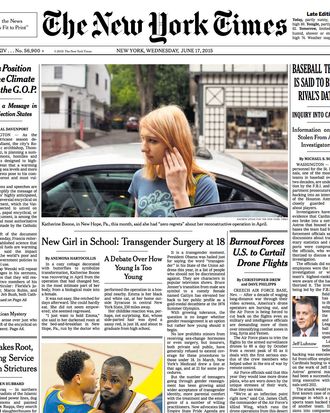
Yesterday, the New York Times ran a cover story on transgender teens who’ve undergone gender-reassignment surgery. It followed a familiar format: The writer gives a nod to transgender figures in public, acknowledges the appearance of transgender characters on TV, mentions the increasing public awareness of transgender issues, and then, somehow, falls prey to transphobia while trying to articulate the struggles of the transgender community.
“It’s a transgender moment,” Anemona Hartocollis wrote, listing Obama’s use of the word transgender in his recent State of the Union, the appearance of trans figures “in popular television shows,” and, of course, Caitlyn Jenner. But in attempting to explore the complexity of minors receiving major surgery, Hartocollis seems unconvinced that trans people could be something other than the sex assigned to them at birth.
“Kat Boone did not fit the stereotype of a girl trapped in a boy’s body,” she writes, a statement that could be more accurately expressed as, “Kat Boone did not fit the stereotype of transgender origin stories the media has rigidly clung to.” Hartocollis then plays to the exhausting and oversimplified boys love cars, girls love dresses rhetoric:
As a child, she dressed in jeans and shirts, like all the other boys, and her best friend was a boy. She liked to play with cars and slash bad guys in the Legend of Zelda video games. She still shuns dresses, preferring skinny jeans and band T-shirts.
Including the notation that a transgender woman wears jeans instead of dresses speaks to how limited our understanding of gender expression is. As Ann Friedman pointed out last week, the media constantly relies on “binary-enforcing phrases like ‘born in the wrong body’ or ‘nature made a mistake,’” which many trans people have said doesn’t accurately express the complexity of their experience.
Hartocollis points to the lack of biological markers for gender dysphoria and wonders whether teenagers “habitually trying on new identities and not known for foresight” should receive such serious surgery. While the medical community is rightfully invested in determining how to satisfy the needs of trans teens without limiting their gender expression later in life, gender dysphoria isn’t equatable to the various “new identities” teens try on. Going goth is often a phase; knowing you’re a girl isn’t. Getting a BFF tattoo with someone you won’t talk to in five years is a decision that “lacks foresight,” but it’s patronizing to suggest that teens who’ve experienced gender dysphoria since childhood don’t know what they need.
Throughout the piece, Hartocollis repeatedly points to how unnatural Boone’s existence is. Mentioning that Boone’s sexual preferences have developed and she now identifies as a lesbian, Hartocollis writes, “her attractions have not been reciprocated.” Describing Boone’s concerns that she won’t find enough privacy in college, Hartocollis writes, “her new vagina needs constant care or it will close off like a wound.”
It’s not unlike the Times’ treatment of Lorena Escalera, a transgender woman who died in a strange fire. The story’s opening line reads, “She was 25 and curvaceous, and she often drew admiring glances in the gritty Brooklyn neighborhood where she was known to invite men for visits to her apartment, her neighbors and the authorities said,” a rather jarring entry into coverage that often opens with mourning, sadness, a community bereaved. The piece repeatedly refuses to respect Escalera’s gender identity, name, or humanity; “Called Lorena” and “According to neighbors, she was born male,” the authors write, before deferring to Escalera’s neighbors themselves who said, “For a man, he was gorgeous,” and “Still, she was a nice person.” The authors note what was in the debris pile from the fire, which included “many colorful items” like wigs, makeup, handbags, and a feather boa. The titillating treatment of Escalera escalates, with the demeaning inclusion of a “a shopping bag from Spandex House” in the list of garbage.
It is not just about “a better choice of words,” as the Times “Metro” editor Carolyn Ryan said in response to the outrage the piece generated. “As my city’s and our nation’s paper of record, I would expect the New York Times to treat any subject, regardless of their path in life, with dignity,” Janet Mock said.
In Lorena Escalera’s life she was so much more than the demeaning, sexist portrait they painted of girls like us … According to the Times’ limiting, harmful portrait of Lorena, she was nothing more than a ‘curvaceous’ bombshell for men to gawk at. That is not the ‘personal’ story of any woman, and until we treat trans women like human beings — in life and death — with dignity, families and struggles, our society will never see us beyond pariahs in our communities.
The Times has repeatedly failed to respect the identities of transgender and gender-nonconforming people, misgendering them or refusing to acknowledge pronouns that aren’t he or she. The most egregious recent example includes the coverage of Sasha Fleischman, a genderqueer teen whose skirt was lit on fire in the back of an Oakland bus. “Sasha prefers ‘they,’ ‘it’ or the invented gender-neutral pronoun ‘xe,” the paper acknowledged, but “The New York Times does not use these terms to refer to individuals.” The question is, why not?




